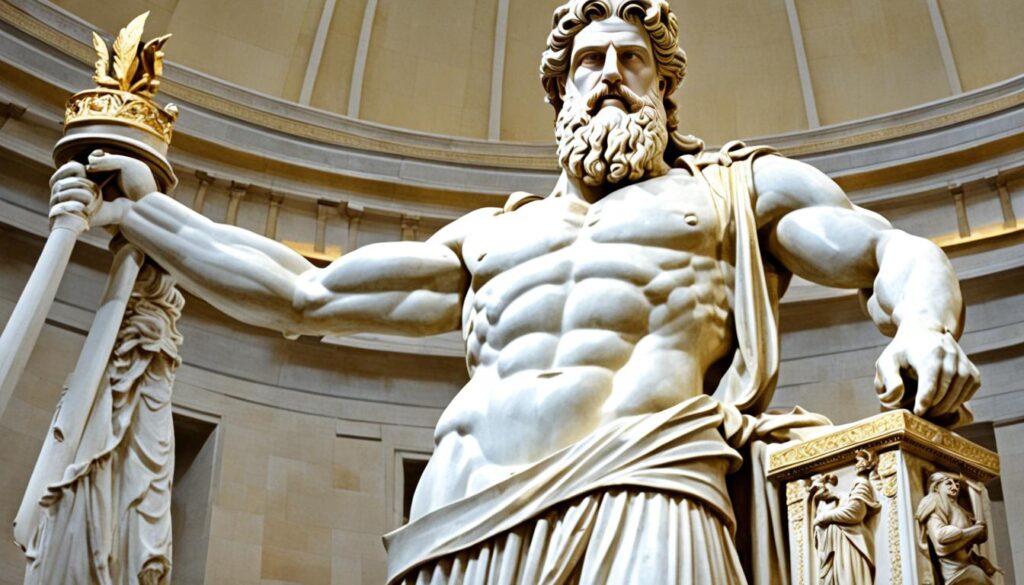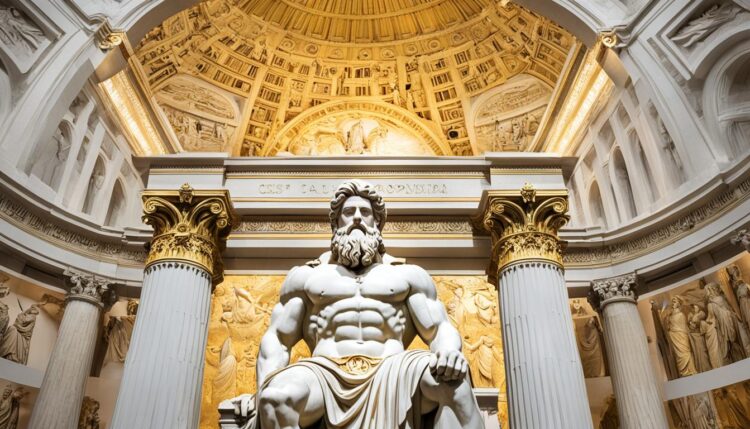Have you ever wondered how one statue could captivate an entire civilization and become a central piece of Greek mythology? The Statue of Zeus at Olympia, a towering figure created around 435 BC by the renowned sculptor Phidias, was more than an ancient sculpture—it was a testament to the reverence of Zeus, the mighty deity of thunder. Standing at an imposing height of 12.4 meters, this masterpiece dominated the temple dedicated to Zeus in Olympia, one of the most important religious and athletic centers of ancient Greece.
Fashioned from ivory and gold, the statue not only showcased the artistic prowess of its time but also epitomized the religious devotion towards Zeus. Despite its ultimate loss and mysterious destruction, the legacy of this majestic statue endures through detailed ancient accounts, continuing to intrigue and inspire to this day. How did such an awe-inspiring figure, once considered one of the Seven Wonders of the Ancient World, leave an indelible mark on history and culture? Discover the fascinating journey of the Statue of Zeus at Olympia and its lasting impact on Greek heritage.
The Significance of the Statue of Zeus at Olympia
The Statue of Zeus at Olympia was more than just a masterpiece of art; it was a central fixture of religious devotion in ancient Greece. The Eleans, who managed the Olympic Games, commissioned this magnificent statue to solidify Olympia’s religious significance and to outshine Athens. This colossal creation soon became a hub of worship and reverence, deeply embedding itself into the spiritual fabric of the region.
Worship and Religious Importance
In ancient Greece, the Statue of Zeus was not just an emblem of artistic prowess but a focal point of worship. Held in the same high regard as the Olympic Games, the statue drew numerous pilgrims who came to pay homage. The Eleans’ ambition was evident as they sought to elevate Olympia’s prestige through this statue, making it a powerful symbol of their city’s religious significance. Strabo’s notes emphasize the statue’s immense size, suggesting it would unroof the temple if it stood, and the continuous anointment with olive oil to prevent dampness further highlighted its sacred stature.
A Central Feature of Olympia
Positioned at the heart of Olympia, the Statue of Zeus served as a spiritual cornerstone for the city. The ceremonial anointing of the statue with olive oil not only preserved it but amplified its grandeur, reflecting the city’s wealth and devotion. Worship of the statue was intertwined with the sacred Olympic Games, held in Zeus’s honor, imbuing the statue with unparalleled religious significance. Romans, including General Aemilius Paullus, experienced profound emotional reactions when viewing this embodiment of divine presence, illustrating the statue’s widespread reverence beyond Greece.
The Master Sculptor: Phidias
Phidias is heralded as a leading Greek sculptor from the ancient world, celebrated for his unrivaled craftsmanship and ambitious projects. He was the mastermind behind some of the most iconic ancient masterpieces, including the imposing Statue of Zeus at Olympia and the esteemed Athena Parthenos in the Parthenon.
Background and Reputation
Born in Athens, Phidias quickly garnered a reputation for his unparalleled skill and innovative techniques in sculpture. His work on the Athena Parthenos carved his name into the annals of Greek history. However, despite his undeniable talent, his career faced turbulence due to accusations of embezzlement related to the Athena Parthenos project. This cloud of controversy threatened to overshadow his accomplishments, making his subsequent commission to create the Statue of Zeus at Olympia an opportunity for redemption.
Phidias’ Workshop Findings
The rediscovery of Phidias’ workshop offered invaluable insight into his creative process and the tools he used. Among the notable findings were tools, ivory fragments, and terracotta molds, all shedding light on the techniques employed to create the intricate details of his ancient masterpieces. Significantly, a cup bearing the inscription “I belong to Phidias” was discovered, providing direct evidence of the workshop where the Greek sculptor brought to life some of his most famous works. This revelation has deepened our understanding of the meticulous methods behind Phidias’ legendary sculptures.
The Temple of Zeus at Olympia
Located in the heart of Olympia, the Temple of Zeus stands as a testament to ancient architecture and religious devotion. This majestic structure, designed by the architect Libon of Elis, took a decade to complete, culminating in 456 BCE. Its Doric columns and grand scale were unmatched, positioning the temple among the most impressive creations of its time.
Serving as the home to the Olympian Zeus, the temple was more than just a building; it was a sacred space that played a central role in the cultural fabric of ancient Greek society. The architectural design ingeniously accommodated the statue of Zeus, creating an awe-inspiring presence that evoked reverence and admiration.
Design and Architecture
The Temple of Zeus exemplified ancient architecture with its massive Doric columns and meticulously crafted sculptures. Standing in Olympia, its grandeur and scale were unparalleled. The temple was strategically designed to provide an imposing backdrop to the colossal statue of Zeus, enhancing the visual and spiritual experience for visitors and worshippers alike.
The Role in the Olympic Games
As the centerpiece of Olympia, the Temple of Zeus held significant influence during the Olympic Games. Athletes and spectators from across the Greek world gathered here to pay their respects to Zeus, the patron god of the games. This sacred venue underscored the profound religious importance attributed to both the temple and the event, intertwining athletic competition with divine worship.
| Aspect | Details |
|---|---|
| Location | Olympia |
| Completion | 456 BCE |
| Architect | Libon of Elis |
| Architectural Style | Doric |
| Role | Sacred venue for the Olympic Games |
Materials and Construction Methods
The Statue of Zeus at Olympia is an outstanding example of ancient craftsmanship, particularly through its use of the chryselephantine technique. This innovative method was pivotal, featuring a combination of gold and ivory over a wooden core, creating the statue’s divine brilliance.
Chryselephantine Technique
The chryselephantine technique was revered in ancient Greece for its ability to convey both opulence and realism. The gold panels blanketed the cedar interior, facilitating an awe-inspiring glow. The ivory, intricately carved and polished, depicted the skin of the deity, imbuing the statue with a lifelike presence. Phidias’s expertise and attention to detail in ancient craftsmanship are evident in every element of this monumental creation.
The Use of Precious Materials
Phidias used a plethora of precious materials, accentuating the magnificence of the sculpture. Gold sheets enveloped the statue’s core, while rare ivory was shaped to perfect the appearance of the god’s flesh. Additionally, the throne was adorned with ebony, gold, precious stones, and other luxurious materials, epitomizing the sophisticated construction techniques of the time. This lavish use of resources not only highlighted the artistry but also symbolized the wealth and power associated with Zeus.
Description of Zeus’ Statue
The Statue of Zeus at Olympia stood as a magnificent representation of ancient sculpture, showcasing the epitome of artistic details and Hellenistic artistry. The renowned work by Phidias portrayed Zeus in a regal form, embodying the divine essence revered by the Greeks.
Height and Proportions
This extraordinary ancient sculpture measured an impressive 12 meters (40 feet) in height. Seated majestically upon a throne, Zeus’ image was designed to evoke awe and reverence among onlookers. The proportions were meticulously crafted to highlight the god’s grandeur and power, making it one of the most iconic representations in Greek art.
Throne and Additional Decorations
The throne on which Zeus sat was an artwork in its own right, adorned with an array of intricate artistic details. Phidias’ masterpiece featured decorative elements such as a wreath of olive sprays and a gold robe embellished with glass-carved animal and lily motifs. Additionally, Zeus donned elaborate sandals, and his scepter was crowned with an eagle, signifying his supreme authority.
In one hand, the statue held the winged goddess Nike, symbolizing victory, while the other hand grasped the scepter. The throne itself was festooned with numerous figures, wrought images, and vibrant paintings, making it an exemplar of sculptural decoration and enhancing Zeus’ image of divinity.
| Feature | Description |
|---|---|
| Height | 12 meters (40 feet) |
| Throne Decorations | Wrought images, vibrant paintings, and figures |
| Artistic Elements | Olive wreath, gold robe with glass carvings, elaborate sandals |
| Symbolic Elements | Winged Nike, eagle-topped scepter |
Cultural Impact and Legacy
The Statue of Zeus at Olympia holds a pivotal place in the cultural legacy of ancient Greece and Rome. This monumental masterpiece, crafted by the renowned sculptor Phidias, set a benchmark for artistic excellence in the ancient world.
Influence on Ancient Greek and Roman Art
The art influence of the Statue of Zeus extended far beyond its immediate vicinity. Ancient Greek and Roman artists drew heavily from its grandeur and stylistic elements. Its awe-inspiring design became a standard reference for sculptors and painters who aspired to capture divine magnificence in their works. Notable artists like Praxiteles and Lysippos echoed Phidias’ artistry in their own creations, perpetuating the cultural legacy of this ancient wonder.
Representation in Coins, Pottery, and Gemstones
Zeus’ statue was not just a physical entity; it became a potent symbol in the ancient representations found in everyday objects. Coins minted during the Hellenistic and Roman periods often featured the likeness of Zeus as conceived by Phidias. Pottery art, widely circulated across ancient Greek and Roman territories, frequently depicted scenes and motifs influenced by the statue’s iconic imagery. Additionally, finely engraved gemstones encapsulated the divine essence of Zeus, mirroring the statue’s detailed craftsmanship.
The Wonders of the Ancient World
The Seven Wonders are a testament to humanity’s extraordinary ability to create breathtaking historical landmarks and ancient marvels. These extraordinary structures have stood the test of time, captivating the imagination of countless generations.
Criteria for Inclusion
The Seven Wonders were selected based on their remarkable construction, aesthetic value, and considerable size. These ancient marvels showcased not only technical skills but also artistic excellence, cementing their status as historical landmarks.
Other Six Wonders
In addition to the Statue of Zeus, the Seven Wonders include:
- Great Pyramid of Giza
- Hanging Gardens of Babylon
- Temple of Artemis
- Mausoleum at Halicarnassus
- Colossus of Rhodes
- Lighthouse of Alexandria
These ancient marvels, together with the Statue of Zeus, represent a fascinating collection of engineering prowess and artistic beauty that commanded respect and wonder throughout history.
Famous Accounts and Descriptions
The Statue of Zeus at Olympia has fascinated historians for centuries, primarily due to the detailed historical accounts provided by notable ancient authors. The testimonies of Strabo and Pausanias offer invaluable insights into the grandeur and sublimity of this ancient marvel.

Strabo’s Observations
Strabo, an esteemed geographer and historian, left behind vivid ancient texts that describe the overwhelming presence of the Statue of Zeus within the temple confines. His observations highlighted the enormous scale and intricate craftsmanship of the statue, underscoring its significant impact on those who beheld it.
Pausanias’ Detailed Description
Pausanias, known for his extensive writings on Greece, provided the most comprehensive detailing of the Statue of Zeus. His historical accounts describe not only the statue’s magnificent appearance but also the artistic intricacies, such as the reflective allure of the olive-oil pool at its feet. Pausanias’ detailed descriptions serve as a crucial link, preserving the grandeur of this lost wonder for future generations.
The Statue in Greek Mythology
The Statue of Zeus at Olympia not only epitomized the artistic brilliance of the ancient world but also deeply resonated with the core of Greek mythology. As the paramount deity, Zeus’s grand sculpture symbolized his unmatched power and authority among the Olympian gods.
Zeus as the King of Gods
Standing tall in the hearts and minds of the ancients, Zeus was the supreme ruler of both gods and mortals. The statue at Olympia captured his majestic essence, portraying him in a dominant and regal posture. Such representation affirmed his status as the king of the Olympian gods, an eternal protector, and the supreme arbiter in the pantheon of Greek mythology.
Symbolism and Mythological References
The Statue of Zeus at Olympia was replete with mythological symbolism. One of the prominent elements was the depiction of Zeus holding a statue of Nike in his right hand, symbolizing victory. Additionally, the eagle perched on his scepter was a clear reference to his dominion over the heavens and earth. These mythological references were not mere decorative elements but resonated with deep cultural and religious significance, embodying the divine authority and reverence Zeus commanded in Greek mythology.
“His figure touched the ceiling even though he was seated, revealing his divinity through grandeur and aesthetic perfection.” – Pausanias
Such accounts reflect the intricate artistry that enveloped mythological symbolism with religious zest, making the statue a crucial emblem of ancient worship and mythology.
The Fate of the Statue of Zeus
The monument once symbolizing the grandeur of ancient Greece faced a complex destiny, particularly intertwined with the Roman Empire’s ascendancy. Various Roman actions influenced the statue’s fate, including attempted relocations, driven by envy and doctrinal shifts towards Christianity.
Roman Interest and Attempts of Relocation
Notable emperors like Caligula eyed the statue of Zeus for relocation to Rome, eager to centralize symbols of power. However, their aspirations were thwarted. A story even recounts how Caligula’s attempt ended in a mysterious sound, interpreted as divine disapproval. Such actions from Roman figures highlight their vested interest in the celebrated statue.
Destruction and Theories around its Loss
Several destruction theories surround the statue’s eventual disappearance. One theory suggests the statue was dismantled for its valuable materials. Another posits that it was destroyed when the temple suffered under the edict of Theodosius II. Alternatively, some believe the statue was transported to Constantinople, ultimately meeting a fiery end. These varied theories illustrate the ongoing debate on the exact circumstances of the statue’s fate.
Rediscovery and Modern Interpretations
Despite its physical absence, the archaeological rediscovery of Phidias’s workshop has played a pivotal role in sustaining the statue’s legacy. Excavations have revealed invaluable artifacts and tools, offering insights into the techniques and methods used by the master sculptor.
These finds, coupled with detailed ancient texts, enable scholars to piece together a comprehensive picture of the Statue of Zeus. Through modern interpretations, including artistic reconstructions and virtual simulations, we continually reimagine this lost masterpiece, reaffirming its cultural and historical significance.
Moreover, the influence of the Statue of Zeus extends beyond the realm of archaeology. It has inspired numerous contemporary artists and creators, reflecting the enduring power and allure of this ancient symbol. The amalgamation of past and present perspectives ensures the statue’s lasting impact on our shared cultural heritage.
| Aspect | Ancient Description | Modern Interpretations |
|---|---|---|
| Artistic Techniques | Chryselephantine method | Virtual reconstructions |
| Materials Used | Gold and ivory | 3D rendering |
| Symbolism | Greek mythology | Cultural inspiration |
Conclusion
The Statue of Zeus at Olympia stands as a pinnacle of ancient history and a beacon of historic significance. Crafted by the master sculptor Phidias, this magnificent creation combined religious devotion with unparalleled artistic ingenuity, encapsulating the essence of ancient Greek art and culture. The statue was more than a mere representation; it was a symbol of divinity, esteemed and revered by the ancients.
Throughout its existence, the Statue of Zeus not only influenced artistic standards but also left a lasting impact on subsequent cultures. From ancient Greek and Roman art to its depiction on various artifacts, the statue’s legacy permeated through time, accentuating the cultural significance that transcends millennia. Descriptions by historians like Strabo and Pausanias have immortalized its splendor, solidifying its place in the annals of art and culture.
As we reflect on the marvels of ancient history, the Statue of Zeus at Olympia remains a testament to human creativity and the enduring spirit that aspires to portray the divine. Although the statue has been lost to time, its enduring legacy continues to inspire and remind us of the incredible achievements of our ancestors in the realm of art and culture.














